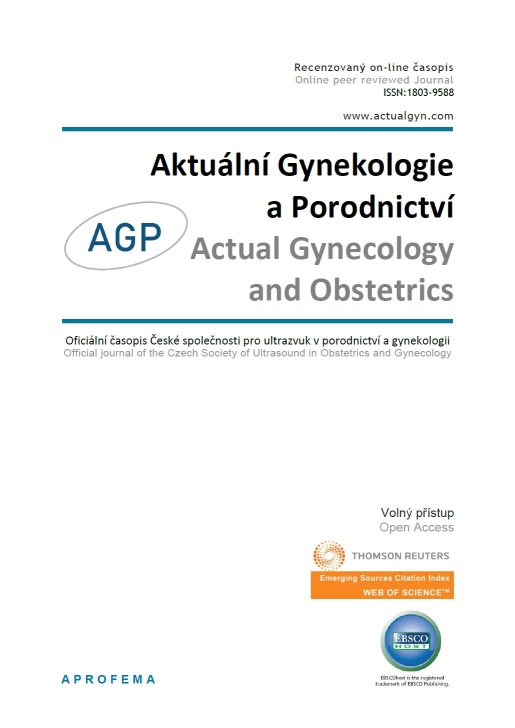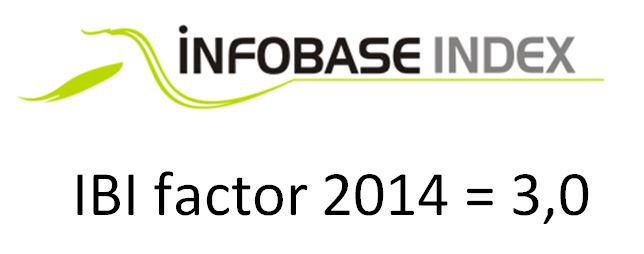











 Official publication of the Czech Society of Ultrasound in Obstetrics and Gynecology.
Official publication of the Czech Society of Ultrasound in Obstetrics and Gynecology.

Mastocytosis represents a group of rare related disorders, with potential for unpredictably heighetned mast cell activity in response to the stress of labour, indicating importance in a management of such condition during pregnancy. We present a case of 34-year-old Caucasian, with remarkable past medical and obstetric history in whom early postpartal period was complicated with anaphylaxis. With this case, we attempt to add to the limited literature demonstrating that the life threatening condition in women with mastocytosis can occur in puerperium after the asymptomatic course of pregnancy and uneventful delivery.
Mastocytosis represents a group of related disorders, each characterized by excessive and pathological mast cell (MC) accumulation in single or multiple organs with the estimated prevalence in all age categories around 13 per 10 000 (1) and with overall of 60 pregnant women with mastocytosis have been published to date (2). This condition is broadly separated in two categories: cutaneous (known as urticaria pigmentosa) and systemic mastocytosis (SM), regarding to where MC infiltration occurs. Clinical presentation of this rare condition is very extensive and has been described (3). It depends on a number of diverse stimuli such as trauma, stress (emotional, physical, mechanical), certain medications and infections among many others, triggering the release of the MC mediators. With endocrine changes and adaptations that occur in pregnancy and very low overall disease prevalence, there is a lack of consistent data on pregnancy outcomes and treatment options in parturients with cutaneous or systemic form of mastocytosis. Mastocytosis is perceived as a medical management dilemma because of its potential for unpredictably heighetned mast cell activity in response to the stress of labour and medications given with the potential for activating the disease. The aim of this case presentation is to amplify knowledge on this rare event in pregnancy and postpartum and to highlight the potential life-threatening mastocytosis related conditions during peripartal care.
A 34-year-old Caucasian, third time pregnant at 39+2 weeks of gestation was admitted into our Department for planned delivery with repeat cesarean section. All of her pregnancies resulted from natural conception.
Her medical history indicates chronical hepatitis B infection (previously treated with interferon in acute stages) and indolent form of systemic mastocytosis with associated urticaria pigmentosa which does not occur before in her relatives, both dating three years before her first pregnancy.
Skin biopsy shows dermal perivascular and interstitial MC aggregates in skin lesions. Bone marrow biopsy was performed with histological pattern locating CD117+ MC aggregates predominantly in subcortical areas with normal hematopoiesis in the noninfiltrated marrow areas encountered.
She reported no allergic or anaphylactoid reactions.
Due to the lack of compliance, she was not using any medications regularly and her condition was stabile. She used combination of cetirizinum (10 mg oral) and loratidinum/pseudoephedrinum (5 mg/125 mg) when necessary and she discontinued its usage in every pregnancy.
Past obstetric history revealed first pregnancy with uncomplicated course, resulting with the vaginal delivery of a full-term newborn. Her second pregnancy was terminated preterm at 34+4 weeks of gestation with emergency cesarean section performed in general anaesthesia due to severe preeclampsia.
Both delivered children are healthy to date.
It is her third pregnancy and she was seen in our clinic from the first trimester.
Because of severe preeclampsia in second pregnancy, she received low-dose aspirin prophylaxis (100 mg daily) from 12 week of gestation in current pregnancy. Uroinfection (E coli > 105) was treated with antibiotics (cefuroxime 500 mg 2 times per day in 7 days total) during the first trimester. On the last day of the antibiotic treatment she reported exacerbation of abdominal skin lesions, which was withdrawed spontaneously shortly after. She refused prescribed medication.
Considering previous cesarean delivery and breech presentation, we made a mutual decision to perform a repeat cesarean section. Cesarean section was conducted with Pfannenstiel incision, in spinal anaesthesia without complications. She gave birth to a healthy girl 3550 g/52 cm. Apgar scores were 10/10 at 1 and 5 minutes, respectively.
During the first postoperative day, because of pain, 75 mg of diclofenac was administered intramuscularly. This was the drug she previously used for menstrual cramps. Within 10 minutes the patient was complaining of throat tightness and difficult breathing. Her systolic blood pressure dropped to 70 mmHg and oxygen saturation dropped to 94%. Oxygene was administered by mask at 10 L/min. Epinephrine 0.05 mg, chloropyramine hydrochloride 20 mg and dexamethason 4 mg were administered intravenously and an arterial line was placed with intravenous volume substitution (2000 mL of saline solution).
Her systolic blood pressure responded to the interventions and remained greater than 110 mmHg, she become haemodynamic stabile and without further complications.
She was discharged in stable condition on postoperative day 4.
Mast cells are important part of immune system participating in inflammatory processes with production of mediators (4). A certain level of mast cell activation is physiological and necessary for maintenance of homeostasis (5). Activation tipically occurs in response to triggers, although none may be identified (6). Clinical manifestations occur secondary to tissue responses to mediators such as histamine, tryptase, leukotrienes and prostaglandines.
Mast cells have important function in pregnancy by contributing to implantation, placentation and fetal growth, having a vital role in the maternal-fetal interface. These cells have both an immunologic and a nonimmunologic role in pregnancy. In early pregnancy, mast cells modulate tissue remodeling, angiogenesis and spiral artery modifications. Yet later, mast cells have the potential to disrupt pregnancy with excessive release of mediators associated with preterm delivery.
In general, studies describing the impact of mastocytosis on pregnancy are limited. Mastocytosis is a rare disorder but with a broad variety of clinical manifestations. Diverse stimuli trigger the release of vasoactive substances and pregnant women with mastocytosis are at high risk for fulminant mast cell degranulation which can lead to bronchospasm, profound anaphylactoid reactions and even cardiovascular collapse (3,7). There are minimal recommendations in the literature regarding medication use in the management of this disease during pregnancy and labour.
Despite our current understanding of mastocytosis, there is a lack of information on how pregnancy might affect clinical features and tolerance of medications and outcomes of pregnant patients with mastocytosis.
The study from Ciach et al. found that the rate of spontaneous miscarriages in Poland appeared to be slightly higher than the rate in the general population in a cohort with mastocytosis (25-30% vs 8-20%) (2). However, whether mastocytosis results in significantly increased rates of adverse maternal or fetal outcomes from that of normal population is unclear. Although the complications of mastocytosis in pregnancy are not well described in the literature, a review of 45 cases of pregnancy in mastocytosis by Matito et al. revealed that 6,6% births were preterm, which is comparable to the European rate (5%) and developed nation rate (8%) of preterm birth (8). Worobec et al. also reported that mastocytosis did not significantly change pregnancy or fetal outcomes (9). The few other smaller case series and case reports suggests similar findings, with no significant complications in labour or delivery (10,11). In general, there is no contraindication for pregnancy if mastocytosis is under appropriate medical control (3,12).
Our report provides unique case of multipara with systemic mastocytosis and a high obstetric risk for preeclampsia. Due to adverse obstetric history and systemic mastocytosis, her third pregnancy was the most challenged. Taking into account potential risk of long-term exposure to salicylates in a patient with mastocytosis, and the importance of preeclampsia prevention, our maternal/fetal medicine consultant recommended low dose aspirin (100 mg daily) from 12th week of gestation. During the pregnancy only one exacerbation of abdominal skin lesions was reported and the preeclampsia was successfully prevented. However, early postpartal period was complicated with anaphylaxis.
NSAIDs fall into three basic categories: traditional NSAIDs, COX-2 inhibitors and salicylates. The rate of NSAID intolerance in patients with SM is 5% (13), a prevalence low enough to allow aspirin therapy to be initiated in the outpatient setting if patients do not have a history of NSAID intolerance (14). Our patient used NSAID (diclofenac) for menstrual cramps and reported no allergic or anaphylactoid reactions.
This case highlights an important lessons. Firstly, pregnancy induced changes in the immune system could be potentially harmful in puerperium of pregnant women with mastocytosis. The enhancement of the innate immune system, the number and concentration of mast cells in circulation has the potential to increase, making any triggered release even more significant. Secondly, labour is clearly a period of increased maternal pain and stress. This events can become triggers for mast cell release in a pregnant woman with systemic mastocytosis. Thirdly, perioperative mast cell degranulation can occur as a result of emotional or physical stress and exposing the patient to an allergen to which they have been senzitized can lead to significant maternal postpartal complications and become catastrophic.
This case highlights an important lessons. Firstly, pregnancy induced changes in the immune system could be potentially harmful in puerperium of pregnant women with mastocytosis. The enhancement of the innate immune system, the number and concentration of mast cells in circulation has the potential to increase, making any triggered release even more significant. Secondly, labour is clearly a period of increased maternal pain and stress. This events can become triggers for mast cell release in a pregnant woman with systemic mastocytosis. Thirdly, perioperative mast cell degranulation can occur as a result of emotional or physical stress and exposing the patient to an allergen to which they have been senzitized can lead to significant maternal postpartal complications and become catastrophic.
Mast cell activation syndrome is an area of ongoing research. The presented case is of both scientific and clinical importance and warns that eventhough the course of high risk pregnancy with prescribed salicylate medication to pregnant woman with mastocytosis went without complications, the administration of the drug from the same group in puerperium may lead to the life-threatening situation due to stress related to delivery that activated the disease. With this case, we attempt to add to the limited literature demonstrating that the life threatening condition in women with mastocytosis can occur in puerperium after the asymptomatic course of pregnancy and uneventful delivery.
In the treatment of pregnant women with mastocytosis ready access to epinephrine, adequate intravenous access and the availability of anesthesia personnel to assist the resuscitation is essential to secure favourable pregnancy outcome.